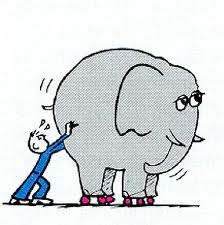All the physical bodies have a property called 'inertia' according to the Newton's first law. That is, a body which is moving in straight line; a body that is rotating or a body at rest, will not change its state easily. It will try to keep on doing what it is doing. Even it will hesitate to change its direction. For humans, inertia can be called laziness. A man finds it is difficult to change his altitude, ideas, work, character.
A giant wheel that is rotating cannot be stopped all of a sudden. It requires great effort and long time.
We are exploding atom bombs now and then, earth gets tremors and earthquake now and then. Did they disturb the rotation of the earth in any way. No, not at all. The earth is huge and heavy. It is rotating at the speed of 1000 km per hour. Heavier the body, greater the inertia. Hence the man made forces is not able to affect the motion of earth. The explosion of atom bomb is like a small prick to the earth at present.
A motor bike is heavy. But a bicycle is not so much heavy. Say, you are riding a motor bike at a high speed, if you turn your bike towards left, the inertia will oppose the direction change and consequently it may slightly turn towards right. This may cause accidents. Hence do not ride the bike at high speed. Car also has the same problem. But it is solved with clever design-ABS brake system.
Now we understand, the inertia is responsible for all the uninterrupted celestial motions.
A train is long and massive. Starting and stopping the train is costly affair-energy wise. We know it is due to inertia. Similarly, landing and taking-off a airplane requires a lot of energy and effort.
Keeping a vehicle in steady motion requires less energy. But to control the vehicle, turning, speeding up, slowing down, stopping , - requires a lot of energy to overcome the inertia.
Have 'moving inertia' in your body and not 'resting inertia'.
-------------------------------------------------------------------------------------------------

